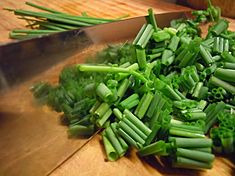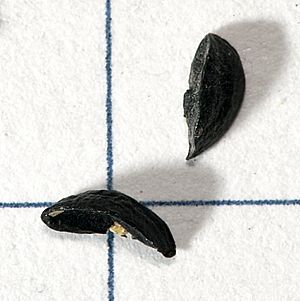Chives facts for kids
Quick facts for kids Chives |
|
|---|---|
 |
|
| Scientific classification | |
| Kingdom: | |
| (unranked): | |
| (unranked): | |
| Order: | |
| Family: | |
| Genus: | |
| Species: |
A. schoenoprasum
|
| Binomial name | |
| Allium schoenoprasum |
|

Cut chive leaves as used for preparing food
|
|
| Nutritional value per 100 g (3.5 oz) | |
|---|---|
| Energy | 126 kJ (30 kcal) |
|
4.35 g
|
|
| Sugars | 1.85 g |
| Dietary fiber | 2.5 g |
|
0.73 g
|
|
|
Protein
|
3.27 g
|
| Vitamins | Quantity
%DV†
|
| Vitamin A equiv.
beta-Carotene
lutein zeaxanthin
|
27%
218 μg
24%
2612 μg323 μg
|
| Thiamine (B1) |
7%
0.078 mg |
| Riboflavin (B2) |
10%
0.115 mg |
| Niacin (B3) |
4%
0.647 mg |
| Pantothenic acid (B5) |
6%
0.324 mg |
| Vitamin B6 |
11%
0.138 mg |
| Folate (B9) |
26%
105 μg |
| Vitamin C |
70%
58.1 mg |
| Vitamin E |
1%
0.21 mg |
| Vitamin K |
203%
212.7 μg |
| Minerals | Quantity
%DV†
|
| Calcium |
9%
92 mg |
| Iron |
12%
1.6 mg |
| Magnesium |
12%
42 mg |
| Manganese |
18%
0.373 mg |
| Phosphorus |
8%
58 mg |
| Potassium |
10%
296 mg |
| Zinc |
6%
0.56 mg |
|
Link to USDA Database entry
|
|
| †Percentages estimated using US recommendations for adults. | |
Chives are a type of plant called Allium schoenoprasum. They are an edible herb, which means you can eat them! Chives are related to other plants you might know, like garlic, shallot, leek, and scallion.
Chives are a perennial plant, which means they live for more than two years. They grow naturally in many parts of Europe, Asia, and North America. You can find chives in grocery stores or grow them easily in your own garden.
Contents
What's in a Name?
Chives were officially described by a Swedish botanist named Carl Linnaeus in 1753.
The scientific name, schoenoprasum, comes from ancient Greek words. Skhoínos means "sedge" or "rush," and práson means "leek." The English name "chives" comes from the French word cive, which came from the Latin word cepa for onion. Long ago, in the Middle Ages, people sometimes called them "rush leeks."
What Do Chives Look Like?
Chives are bulb-forming plants that grow up to 30 to 50 centimeters (about 12 to 20 inches) tall. They grow in clumps from their roots. The bulbs are small and cone-shaped.
The stems of chives are hollow and look like thin tubes. They can be up to 50 centimeters long. The leaves are also hollow and round, like grass. This is how you can tell them apart from garlic chives, which have flat leaves.
Chive flowers are pale purple and shaped like stars. Each flower has six petals and is about 1 to 2 centimeters wide. Many flowers grow together in a dense cluster. Before they open, the cluster is covered by a papery leaf. After flowering, small seeds grow inside a tiny capsule. Chives usually flower in spring or early summer.
Chives are special because they are the only type of Allium plant that grows naturally in both the New (North and South America) and the Old World (Europe, Asia, Africa).
Even though chives have sulfur compounds that can keep some insects away, their flowers are very attractive to bees. This means they can help bring helpful insects to a garden.
Where Do Chives Grow?
Chives grow naturally in cool areas of Europe, Asia, and North America.
You can find them in many countries across these continents. For example, they grow in places like China, Japan, Russia, Germany, France, the United Kingdom, Canada, and the United States.
How Are Chives Used?
In the Kitchen
Chives are grown for their stems and leaves, which are used to add flavor to food. They have a mild onion-like taste, but it's not as strong as regular onions.
Chives are used in many different dishes around the world. In Sweden, they are often eaten with pancakes, soups, fish, and sandwiches. They are also a key ingredient in a traditional sauce served with herring during Swedish midsummer celebrations. The pretty purple flowers can also be used to decorate dishes.
In Poland and Germany, chives are often served with a soft cheese called quark. In French cooking, chives are one of the "fines herbes," which are a mix of fresh herbs like tarragon, chervil, and parsley.
You can usually buy fresh chives in stores all year round. You can also freeze them to keep their flavor, which is great if you grow a lot in your garden!
In the Garden
Farmers sometimes plant chives around their flowerbeds. This helps to keep unwanted insects, like Japanese beetles, away from other plants. The juice from chive leaves can also be used to fight fungal infections and other plant diseases.
For Health
Chives have some health benefits, similar to garlic, but they are much milder. They can act as a mild stimulant and help your body get rid of extra water (a diuretic). They also have some antiseptic properties, which means they can help fight germs.
Since chives are usually eaten in small amounts, they rarely cause any problems. However, eating too many might sometimes upset your stomach.
How to Grow Chives
Chives are grown for cooking and also because their violet flowers look beautiful. The flowers are edible too and can be added to salads or used to make flavored vinegars.
Chives like soil that drains well and has lots of good stuff in it, with a pH level of 6-7. They also need plenty of sunshine. You can grow them from seeds, and they will be ready to harvest in the summer or the next spring.
To grow from seeds, keep them moist and at a temperature of about 15 to 20 degrees Celsius (60-70 degrees Fahrenheit). If you live in a colder place, you can start the seeds indoors and then plant the young chives outside after about four weeks. You can also easily grow new chive plants by dividing existing clumps.
In cold places, chives will die back in winter, but new leaves will grow again in early spring. If your chive plants start to look old, you can cut them back to about 2-5 centimeters (1-2 inches) from the ground. When you harvest, just cut the number of stalks you need from the base of the plant. The plant will keep growing new leaves, so you can harvest them many times during the growing season.
Sometimes, a pest called the leek moth can damage chives by boring into their leaves or bulbs.
Chives Through History
People have been growing chives in Europe since the Middle Ages (from the 5th to the 15th centuries). But their use goes back even further, about 5,000 years!
The ancient Romans thought chives could help with sunburn and sore throats. They also believed eating chives could raise blood pressure and help you pee more.
Romani people used chives in fortune telling. They believed that hanging bunches of dried chives around a house could protect against sickness and evil.
In the 1800s, farmers in the Dutch fed chives to their cows. They did this to give a different taste to the cows' milk.
Images for kids
See also
 In Spanish: Cebollino para niños
In Spanish: Cebollino para niños




